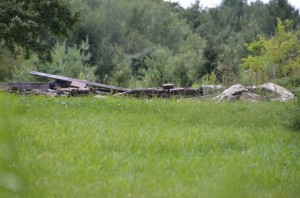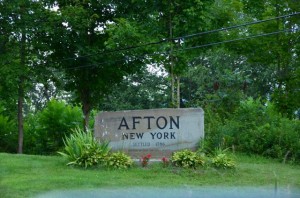Pilgrimage to Poet’s Hometown Yields Some Answers
Purchase William E. Dimorier: Servant Leader
Last weekend, Husband Jim and I made the six-hour trip to Afton, NY, the home of William E. Dimorier (1871-1951), the poet and educator I have been researching for nearly a decade. Now that the project is ready to wrap up, I didn’t think I could call it complete without physically visiting his birthplace. After spending two days in the area, I came away from the experience with some questions answered and the realization that there are other questions that will likely remain mysteries forever, trapped in the past.

I have been fortunate over these years to have the assistance of Charles Decker, Afton Historian, who has provided me with photocopies and data about Dimorier and his family. Mr. Decker has been historian since the 1970s and has contributed more than 1,000 articles to his weekly “The Way We Were” column in the Tri-Town News. His contributions have been invaluable to the Dimorier project, so I was very happy to meet him at the Afton Museum.
I am also fortunate that Mr. Dimorier’s great-niece, Beverly Wood Douglas and her lifelong friend, Pat Dean, met us in Afton to spend the day showing us around the area. Beverly drove all the way from Towanda, PA, and Pat lives in the area now after some years away. Without these two women as our guides, we would have been quite literally lost. I shared a list of places I wanted to take pictures of, and they patiently directed Jim, the navigator, over miles of narrow roads once populated with farms, but now tree-covered because of the CCC program (Civilian Conservation Corps) during the Great Depression.

Bev and Pat guided us to a location on Melondy Hill and Hunt Roads where her grandparents once owned a farm. That is where William Dimorier spent the last years of his life, with his sister, Mary, and her husband, Burt Wood. The farm is nothing but ruins now. The house is completely flattened, and the barn is barely standing. Bev also showed us the corner where Melondy Hill School once stood. That is one of the schools where William taught.

Our guides also took us to William’s grave in Glenwood Cemetery. It was an emotional experience to stand at the grave of this man I admire so much. His headstone reads, “Home is the sailor, home from the sea, And the hunter home from the hill.” (from “Requiem” by Robert Louis Stevenson) and “I know that my redeemer liveth.” These two passages are fitting because much of his poetry refers to both the sea and religious themes.
We were unable to find the home that William Dimorier was born in, and there’s even some confusion about which town he was born in, Afton or Sanford. Some records say his birthplace was Sanford, but his obituary lists both his birthplace and place of death as Afton. There are records that show the family in Sanford, Afton, and Colesville in overlapping periods of time, too. An Afton village directory from 1902 places William, his father Robert, and brother John, on Orchard Street (no street number), and a 1908 map shows land owned by R.H. Dimorier in Sanford. By that time, Dimorier was in Erie, teaching.
Regarding teaching, and why Dimorier didn’t graduate from high school until he was 26, I believe we have that mystery solved. At the Afton Museum, we saw a picture of Pearl Dimorier, who is probably some relation to William, but I have to remind myself that this is not a genealogy project. The description of her photo says that she taught school in the North Afton district, and when she earned her high school diploma, she taught fourth grade there, too.
I learned that back in the 1800s, school teachers needed only an eighth-grade education and were certified by the local authorities. Dimorier’s obituary in the Afton Enterprise states that, “Prior to his college days, Mr. Dimorier taught school at Russell Hill School, Melondy Hill, the Baker District, and at Vallonia Springs.” In 1897, New York State started to impose higher standards for teachers, and this date correlates with Dimorier’s high school graduation at the age of 26. Earning a high school diploma was not enough for Dimorier, though. He went on to Colgate for a bachelor’s degree and later, he earned a master’s degree.
Dimorier Deserves Recognition
At the Afton Museum, I photographed some historic pictures and a few letters sent to Dimorier’s sister, Mary Wood. Some of the letters were from her brothers, and one was from her mother. Unfortunately, there were no letters from William Dimorier to his sister. There was, however, a card sent to Mary from someone in Erie, expressing sympathy upon William’s passing. The letter discussed how this woman wished she and her husband had visited Mr. Dimorier in Afton instead of just talking about it. She stated that she wished William had married, because he was always so lonely at holiday times. It also expressed sadness that William had given so much to the Erie School District, and that when he retired, not one of the groups he had been involved with held any ceremonies to honor his contributions (they did honor him in a yearbook, though).
Having empathy for the unappreciated, the note to Mary affirmed my desire to achieve recognition for Dimorier by the Erie School District and his home town of Afton. This is a man who spent countless hours at Academy High School guiding student clubs, managing the Academy Singers, and supporting the athletics programs. He was the driving force behind the “Athletic Field” (now Ainsworth Field) and Veterans’ Stadium in front of Academy High School. And he was a poet.





Leave a Reply